Exchange Server Backup and Restore
BackupAssist Version 6
1. Introduction
1.1 Overview
This whitepaper outlines how to perform live backups of your Exchange Server's information store database. For information on backing up individual mailboxes of an Exchange Server see our Exchange Mailbox Add-on whitepaper: www.backupassist.com/downloads/whitepapers/ExchangeMailboxBackup_WP.pdf
1.2 Requirements
To back up and restore your Exchange Server information store using BackupAssist you need the following:
- BackupAssist v6
· Windows 2000, XP, Server 2003, Server 2008 or Server 2008R2.
· Microsoft Exchange Server 2000, 2003, 2007, or 2010
· Windows Backup (NTBackup) or Volume Shadow Copy (VSS):
|
NTBackup of Exchange server |
||||||
|
Win 2000 |
Win XP |
Win 2003 |
Win 2008 |
Win 2008R2 |
||
|
Exchange 2000 |
|
|
|
|
|
|
|
Exchange 2003 |
|
|
|
|
|
|
|
Exchange 2007 |
|
|
|
|
|
|
|
Exchange 2010 |
|
|
|
|
|
|
|
VSS backup of Exchange 2003, 2007, 2010 |
||||||
|
File replication |
|
|
|
|
|
|
|
Rsync |
|
|
|
|
|
|
|
Zip |
|
|
|
|
|
|
|
Windows imaging |
|
|
|
|
|
|
1.3 Local and remote backups of Exchange
|
BackupAssist running on
|
BackupAssist running on
|
|
|
Local Exchange information store backup |
|
Using the NTBackup engine (Exchange 2000, 2003 and 2007) |
|
Remote Exchange information store backup |
|
Using the NTBackup engine (Exchange 2000, 2003 and 2007). |
|
Local Exchange mailbox backup |
|
2 |
|
Remote Exchange mailbox backup |
2 |
2 |
1.3.1 Remote Exchange 2007 backup requirements
If you are attempting to back up an Exchange 2007 Server remotely (i.e. Exchange 2007 is running on a different server than your backup server) you will need to install the Exchange Server Management Tools on the machine where BackupAssist is installed, which should be a machine running Windows 2000, XP or 2003. NTBackup will be used to back up the remote Exchange information store.
Note : this method cannot be used to back up Exchange 2010 remotely.
1. If BackupAssist is running on a 32-bit operating system:
Download and install the Exchange Server 2007 Management Tools (32-bit):
2. If BackupAssist is running on a 64-bit operating system:
Install the Exchange Server 2007 Management Tools (64-bit) from the installation disc or setup file used to install Exchange 2007 on your remote server.
If you have installed a version of Exchange Server 2007 that came pre-packaged with Exchange 2007 Service Pack 1, you will need to make a small alteration to the Windows registry due to a change made by Microsoft.
Note : if you installed Service Pack 1 after installing Exchange Server 2007 the change should not be required.
Excerpt from Microsoft article:
To adhere to the Microsoft Secure by Default initiative, the remote streaming functionality (server-wide) in Exchange 2007 SP1 is disabled by default. A manual override in the form of the following registry value must be enabled to restore this functionality:
HKEY_LOCAL_MACHINE\System\CurrentControlSet\Services\MSExchangeIS\ParametersSystem
Name: Enable Remote Streaming Backup
Type: DWORD
Value: 0 = default behavior (remote backup disabled); 1 = remote backup enabled
Refer to http://technet.microsoft.com/en-us/library/aa998870.aspx for full instructions.
2. Backing up Exchange using NTBackup
2.1 Creating a NTBackup job
If you are running BackupAssist on a Windows 2000, XP, or 2003 machine and need to back up Exchange Server either locally or remotely, complete the following steps to create a backup job. If you already have an NTBackup job you can skip to section 2.2.
1. Launch BackupAssist and from the File menu select New backup job.
2. Choose NTBackup and click Next.
3. Continue configuring the job according to your requirements. You will need to configure Exchange backup after you have finished creating the job. This is described in section 2.2.
4. If you do not need to select data in the Files and folders step, click Next and then Ignore when prompted.
5. Once you have created your backup job you will be taken to the job edit window:

2.2 Adding an Exchange Server to your backup selections
To back up the information store using NTBackup you must add it to the Exchange Servers Window. Once added, there are two types of Exchange Server backup you can configure:
- Information store: entire Exchange Server database
- Individual mailbox: brick-level backup of user mailboxes (requires the Exchange Mailbox Add-on). For details on mailbox backups refer to theExchange Mailbox Add-on white paper.
To add an Exchange Server to your job:
1. From the left menu under Job settings select Exchange Servers.
2. Within the Exchange Server selection section click Add Exchange Server. A window will appear that displays all of the available Exchange Servers on the network.

Note : If your Exchange Server resides on a different domain to that of the machine where BackupAssist is installed you can enter the name or IP address of the Exchange Server and click Search.
3. Click Add to add the selected Exchange Servers to your backup selections.
4. Check Backup storage groups for each Exchange Server you want to back up.
5. Now select which storage groups to back up for each Exchange Server:
o Check Select all storage groups if you wish to back up all storage groups and any future storage groups that are created (recommended). You can exclude specific storage groups if required by unchecking them, but all future storage groups created will still be backed up.
o Or, leave Select all storage groups unchecked and individually check each storage group to back up. No storage groups created in the future will be backed up, only those selected.
6. Click Apply changes when you have finished making your selections.
3. Restoring Exchange using NTBackup
Restoring an Exchange Server from a backup created using NTBackup requires three steps. This example follows from the backup process completed during section 2. This example assumes that Exchange Server is installed on the system. If you backed up Exchange Server using a VSS application backup refer to section 6 for the required restoration steps.
Step 1: Dismounting Exchange Server stores
Before you can restore your Exchange Server database you need to dismount the stores you are restoring to:
1. Launch the Exchange System Manager from the Start menu.
2. Expand the Servers tree to locate the appropriate server and storage group (screenshot below).
3. Right-click each store individually (typically Mailbox Store and Public Folder Store) and select Dismount Store:
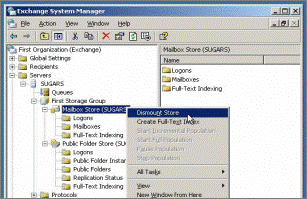
4. Your stores should have an icon with a red arrow to indicate that they have been dismounted:
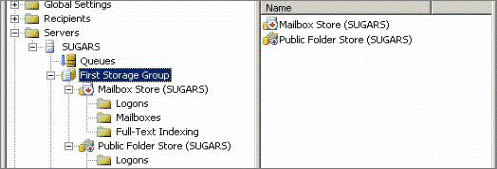
Step 2: Performing the Exchange restore using NTBackup
Run Windows Backup (NTBackup) to restore your Exchange Server database:
1. Go to Start Menu > All Programs > Accessories > System Tools > Backup
2. If Windows Backup launches in Wizard Mode click the Advanced Mode link
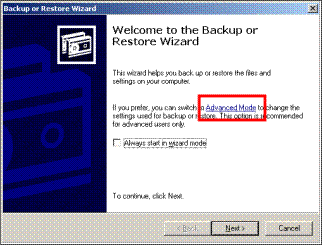
3. [Optional - remote restore]: If you are restoring to a remote Exchange Server click the Backup tab and then select Tools > Remote store from the top menu and enter the name of your remote Exchange Server.
4. Now click the Restore and manage media tab.
5. Locate the backup file or tape you wish to restore from and expand this tree until you locate the Exchange Server Information Store. If the backup required is not listed click Tools > Catalog backup file to locate the appropriate backup.
6. Select each storage group you wish to restore:

7. Click Start Restore. You will be prompted with several choices:

o In this example we are restoring to a local Exchange Server so the Restore To field has been filled with the computer name of the local machine.
o The Temporary location for log and patch files should be any directory with enough free space to perform the restore. Windows Backup will create the directory if it does not already exist.
o If you are restoring a full backup of Exchange ensure that the last two options are checked. If you are restoring an incremental or differential backup, you should refer to the section 8 for help.
8. Click OK to begin the restore of your Exchange Server.
Step 3: Checking the restore logs
Once the restore is complete, you should see the following window Restore Progress window:
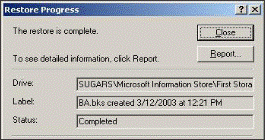
Click Report to view the logs, which will show the results of the Exchange Server restore operation:

If the logs do not indicate any errors, we recommended that you now reboot your server. Your Exchange information store should be restored, mounted and operational.
4. Backing up Exchange using VSS
4.1 Creating a VSS application backup job
If you are running Exchange Server locally on the same machine where BackupAssist is installed, and are using an operating system with Volume Shadow Copy present (Windows XP/2003 and later), complete the following to back up your Exchange Server information store:
1. Launch BackupAssist and from the File menu select New backup job.
2. Select Windows Imaging, File Replication, Zip, or Rsync and click Next.
3. During the Files and Folders step select the Exchange Server and any other VSS applications that you want to back up:
Note : locally installed VSS applications will be automatically detected and listed for selection. In some cases only applications that are currentlyrunning will be detected. If an application is not listed in the Files and Folders tab, try re-starting it and then click the Refresh button in BackupAssist.
Imaging jobs (Server 2008 and REV / rdx / NAS jobs on Server 2008R2)
For Imaging jobs running on Windows Server 2008 or jobs backing up to a REV or rdx drive or a NAS device on Windows Server 2008 R2, VSS applications can be selected from the Applications tab, but are backed up as part of a full volume snapshot. Volumes containing a VSS application that you want to back up must be fully selected. If you choose a VSS application to back up, the volumes that must be included for backup are listed in red. You can click the Select required volumes button if a required volume is not in your selections.
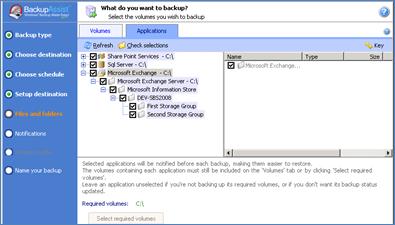
File Replication, Zip and Imaging jobs
You can select either entire VSS applications to back up or choose individual components:
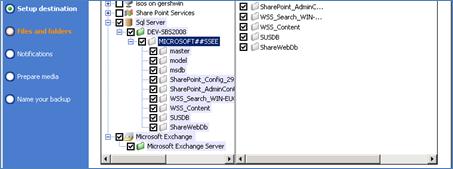
4. If you are editing an existing job, navigate to Volume selection from the left menu for a Windows Imaging job on Server 2008 and Files and folders from the left menu for any other job:
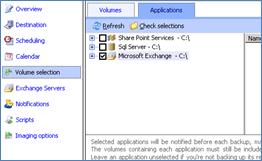
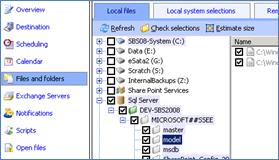
5. Running a backup of your Exchange Server
To test your Exchange Server backup you can either run your backup job manually or wait for the next scheduled backup to occur.
When an Imaging, File Replication, Rsync or Zip job runs, BackupAssist will automatically perform a consistency check on your Exchange Server and truncate log files to correctly back up the Exchange information store. If, however, the VSS backup mode is set to 'Copy' in the open files tab of a File Replication, Rsync, or Zip job, the Exchange logs will not be truncated.
For NTBackup jobs BackupAssist backs up your Exchange Server during the second phase of the backup process, after the selected data files and system state (both optional) have been backed up. (This helps to eliminate an issue with Windows Backup (NTBackup) where a backup of both the system state and Exchange Server information store in the same pass fails.)
To run a backup of your Exchange Server manually:
1. Click Quick actions from the top menu of BackupAssist and select Run now.
2. Choose Run a future backup and click Run.
3. During the backup process you can view the job's progress in the Monitor window:
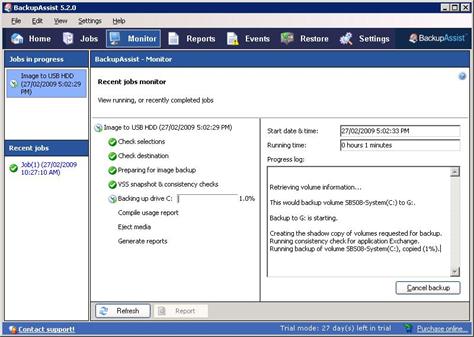 <
<
5.1 Examining your backup logs
Once the backup completes, you should examine the backup report to make sure your Exchange Server was backed up successfully:
1. Click Reports in main navigation bar of BackupAssist.
2. Double-click the latest report in the list and scroll down to the Exchange Server backup report section.
For NTBackup jobs the report will include the backup and verify status of each storage group selected:
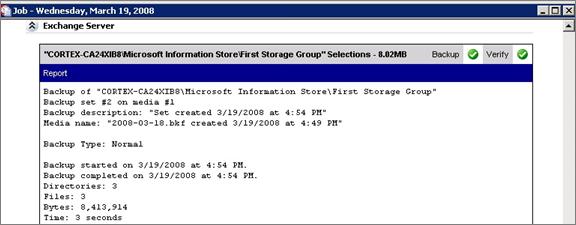
For VSS application backup jobs the report will include an Exchange Database Consistency Check report and a VSS application backup report:
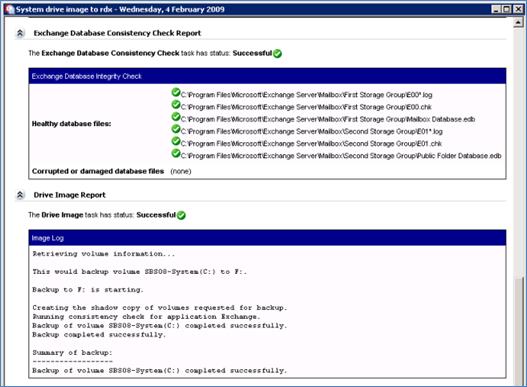
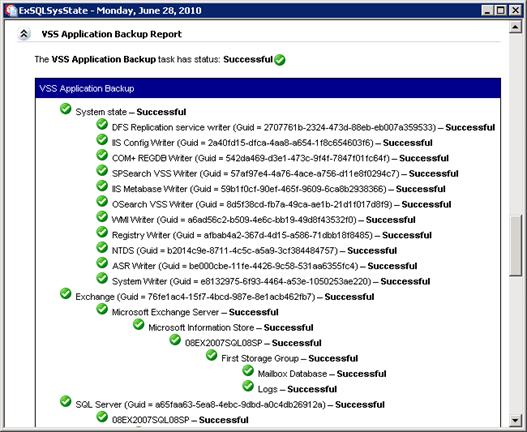
The Exchange System Manager will also indicate when the last full backup occurred on Exchange:
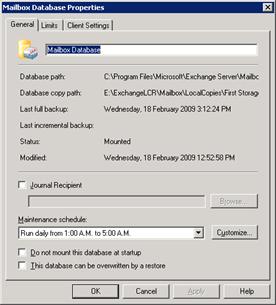
6. Restoring Exchange from a VSS application backup
If you backed up your Exchange Server using VSS, as outlined in section 3 of this document, you can use the BackupAssist Restore Console to perform a VSS application restore of your entire Exchange Server:
1. In BackupAssist, click Restore in the top navigation bar and choose BackupAssist Restore Console.
2. The Restore Console will launch and you will be prompted with the 'Load backups' screen.
3. Click Load all known backups to load all backup catalogues located in the BackupAssist settings folder. Alternatively, use the Browse option to locate the backup set from which you want to restore.
4. Choose the job that corresponds to the backup from which you want to restore your Exchange Server from the available drop-down menu.
5. Use the calendar to select the date of the backup from which you want to restore.
6. Use the middle pane to expand the loaded backup set and select the Microsoft Exchange for restore.
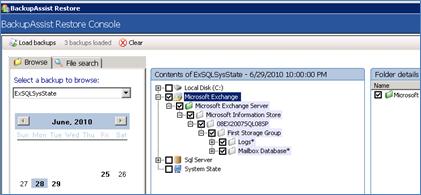
7. Click the Restore to button located on the bottom right of the window and follow the remaining prompts to your restore your Exchange Server.
How the VSS application restore works
VSS is designed to support live application restore. This means that you do not need to stop your Exchange Server before recovering a previous version
of it from a backup.
If any Windows services need to be stopped and restarted during an application restore this will happen automatically. For example, during the restore of an Exchange database, the Exchange Server will prevent client access to that database. So while we recommend that you notify all users to stop using any applications before commencing a VSS application restore, the restore process will not be affected if the Exchange Server is in use.
7. Restoring mailboxes via a Recovery Storage group
The following process is useful if you have not setup mailbox backups to PST using the BackupAssist Exchange Mailbox Add-on and only want to recover one or more mailboxes rather than the entire Exchange Server.
7.1 Perquisites for recovery process
To restore Exchange 2007 or Exchange 2010 mailboxes from a full drive image backup created using the Windows Imaging engine in BackupAssist:
1. Complete the restore operation on a machine running Windows Server 2008 and Server 2008R2. (Windows Vista and Windows 7 only provide support for drive volume restore.)
2. Log into the machine as a user that is a member of the Backup Operators or Administrators group, or one that has been delegated the appropriate authority.
3. Ensure the following registry key contains the string value highlighted below:
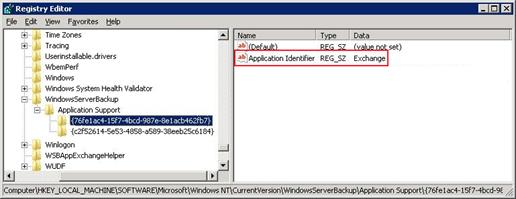
HKEY_LOCAL_MACHINE\SOFTWARE\Microsoft\Windows NT\CurrentVersion\WindowsServerBackup\Application Support\
String information
String name: Application Identifier
Data: Exchange
7.2 Performing a recovery of your Exchange Server from an Image backup
After you have met the above prerequisites follow these steps to restore Exchange to a recovery storage group:
1. Launch BackupAssist and click Restore in the navigation bar.
2. Click Imaging engine restore to launch the Windows Server Backup console.
3. Click Recover under the Actions pane.
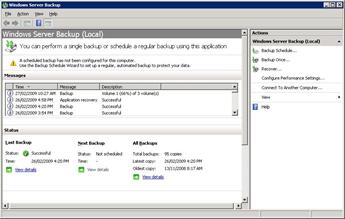
4. Once the Recovery Wizard has launched, select "This server", and then click Next.
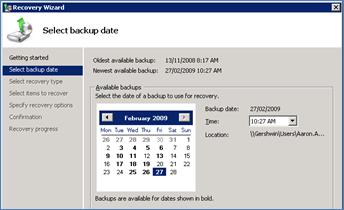
5. Select the date from the calendar and the time from the drop-down list of the backup from which you want to restore. If you are recovering from this computer and the backup you select is stored on a removable media drive, you will be prompted to insert the relevant media. Then click Next.
6. When asked what you would like to recover, choose the option for Applications, and click Next.
7. Under Applications, highlight 'Exchange', and then click Next.
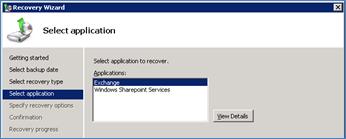
8. Under Recovery destination, select Recover to another location, select a directory located on the Exchange server, then click Next.
9. Review the details, and click Recover to restore the Exchange databases to the chosen directory.
6.3 Creating and populating the Recovery storage group.
1. Once the recovery process has completed navigate to the directory containing the backup of your storage group. You will need to rename all of the files in this directory beginning with an 'E' to begin with 'R'. This includes all of your log files.
Initially you will have:

After the renaming you would have:

2. You will now need to create a Recovery Storage Group to mount the database you are restoring. Begin by launching your Exchange Management Console and opening the Disaster recovery toolbox from the Toolbox node in the Exchange tree.
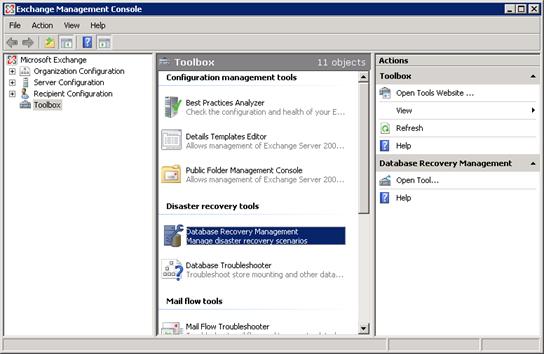
3. When the Disaster recovery toolbox loads, you will need to specify your server's name in order to connect to it. Enter the required details and click Next.
4. You can now make a Recovery Storage group by clicking Create Recovery storage group.
5. Once the wizard begins, select the storage group to restore to the RSG, and choose Next.
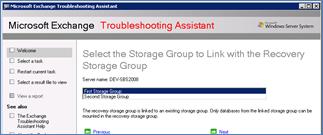
6. It is recommended that you use the default settings for the creation of the recovery storage group for ease of recovery. Make a note of the Recovery database path as you will need it in a few minutes. Once you have done this click Create recovery storage group and complete the wizard.
7. Once you have completed the wizard, launch an explorer window and navigate to the Recovery database path. Copy the renamed files from step 1 into this folder.
8. After copying the renamed database files go back to the Disaster recovery toolbox and click Mount or dismount databases in the Recovery storage group. Select the newly created RSG and mount it.
6.4 Performing merge from your Recovery storage group.
1. Once the RSG has mounted click Merge or copy mailbox contents.
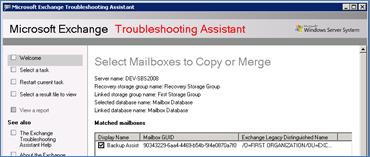
2. Ensure the correct mailbox is listed in the recovery storage group and click Gather merge information.
3. Double check the merge details then click Perform pre-merge tasks.
4. Select the mailboxes you wish to merge and then choose Perform merge actions.
5. Check the merge results to verify that all tasks were successful and click Go back to task centre.
Do not forget to remove the Recovery storage group after you have finished using it. This can be done by using the Remove the recovery storage group option from within the disaster recovery toolbox.
7. Additional Resources
Microsoft Technet has some detailed article on Exchange. For more information visit these sites:
|
Resource |
Web Address |
|
Exchange 2003 Disaster Recovery |
|
|
Exchange 2003 Administration Guide |
|
|
Exchange Server Resources |
[1] Refer to the Remote Exchange 2007 requirements section for more information.
[2]Requires an Exchange Mailbox Add-on license. Refer to our Exchange Mailbox Whitepaper for more information.
[3] This is not available in Windows XP or 2003
[4] Imaging jobs running on Windows Server 2008R2 only (excludes jobs backing up to REV / rdx drives)
[5] BackupAssist disclaims any responsibility for the content or accuracy of these articles.

 Belgium
Belgium Canada
Canada Germany
Germany Italy
Italy France
France Spain
Spain United Kingdom
United Kingdom

